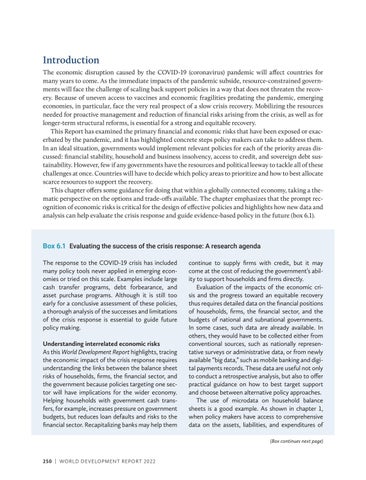Introduction The economic disruption caused by the COVID-19 (coronavirus) pandemic will affect countries for many years to come. As the immediate impacts of the pandemic subside, resource-constrained governments will face the challenge of scaling back support policies in a way that does not threaten the recovery. Because of uneven access to vaccines and economic fragilities predating the pandemic, emerging economies, in particular, face the very real prospect of a slow crisis recovery. Mobilizing the resources needed for proactive management and reduction of financial risks arising from the crisis, as well as for longer-term structural reforms, is essential for a strong and equitable recovery. This Report has examined the primary financial and economic risks that have been exposed or exacerbated by the pandemic, and it has highlighted concrete steps policy makers can take to address them. In an ideal situation, governments would implement relevant policies for each of the priority areas discussed: financial stability, household and business insolvency, access to credit, and sovereign debt sustainability. However, few if any governments have the resources and political leeway to tackle all of these challenges at once. Countries will have to decide which policy areas to prioritize and how to best allocate scarce resources to support the recovery. This chapter offers some guidance for doing that within a globally connected economy, taking a thematic perspective on the options and trade-offs available. The chapter emphasizes that the prompt recognition of economic risks is critical for the design of effective policies and highlights how new data and analysis can help evaluate the crisis response and guide evidence-based policy in the future (box 6.1).
Box 6.1 Evaluating the success of the crisis response: A research agenda The response to the COVID-19 crisis has included many policy tools never applied in emerging economies or tried on this scale. Examples include large cash transfer programs, debt forbearance, and asset purchase programs. Although it is still too early for a conclusive assessment of these policies, a thorough analysis of the successes and limitations of the crisis response is essential to guide future policy making. Understanding interrelated economic risks As this World Development Report highlights, tracing the economic impact of the crisis response requires understanding the links between the balance sheet risks of households, firms, the financial sector, and the government because policies targeting one sector will have implications for the wider economy. Helping households with government cash transfers, for example, increases pressure on government budgets, but reduces loan defaults and risks to the financial sector. Recapitalizing banks may help them
continue to supply firms with credit, but it may come at the cost of reducing the government’s ability to support households and firms directly. Evaluation of the impacts of the economic crisis and the progress toward an equitable recovery thus requires detailed data on the financial positions of households, firms, the financial sector, and the budgets of national and subnational governments. In some cases, such data are already available. In others, they would have to be collected either from conventional sources, such as nationally representative surveys or administrative data, or from newly available “big data,” such as mobile banking and digital payments records. These data are useful not only to conduct a retrospective analysis, but also to offer practical guidance on how to best target support and choose between alternative policy approaches. The use of microdata on household balance sheets is a good example. As shown in chapter 1, when policy makers have access to comprehensive data on the assets, liabilities, and expenditures of (Box continues next page)
250 | WORLD DE VELOPMENT REPORT 2022

